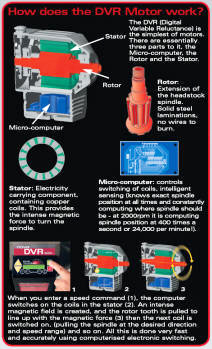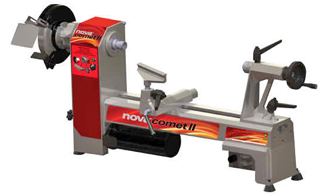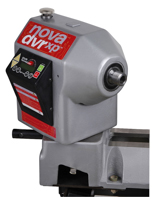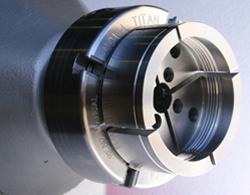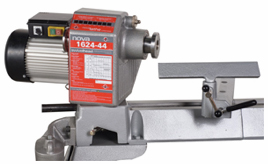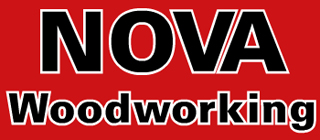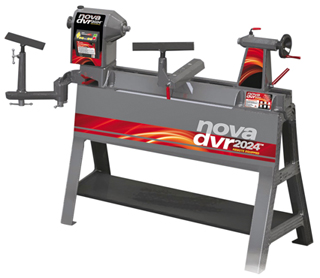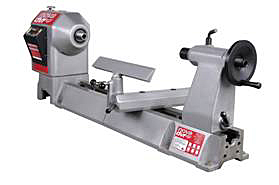When it comes to lathes, if you could build a better mousetrap, what would your ideal machine be? Wouldn’t it be great to eliminate the belt-and-pulley transmissions that drive most of today’s conventional lathes and trade that contraption for full-range variable speed? How about a motor that senses the force you are applying to the wood and compensates by adding more power to keep your turning speed constant? And, wouldn’t it be cool if the lathe knew the moment you have a “dig in” so it could stop itself instantly and prevent a mishap?
You don’t have to imagine this stuff … it already exists on a number ofTeknatool lathes featuring DVR (Digital Variable Reluctance) motor technology. These were the sorts of innovative developments that the Latimer family — founder Harold and sons Brian and Roger — were formulating almost a decade ago from their home base in Auckland, New Zealand.
Brian Latimer, Teknatool’s director of sales and marketing, sums up the family’s urge to push woodturning technology forward this way: “Others have taken a traditional approach to woodturning; we have not. Through the years, we have repeatedly thrown preconceived notions out the window and started fresh.” And that fresh perspective has won the company international accolades from both industry and the woodworking community. It also has helped set the bar for work-holding systems and lathe development for a long time.
But it wasn’t always about woodturning for Harold. After his service in World War II, the elder Latimer channeled his skills as an accomplished artist and engineer into building various components as a parts supplier for other companies. “My father was a naturally innovative person and didn’t really know his limits. His knowledge of foundry processes and metallurgy were a good fit for starting a light manufacturing business, which at the time was called Latalex Limited. Boating was a huge industry in New Zealand in the 1950s, so Dad made a variety of marine fittings and hardware. He also devised a novel way of molding plastics to make boat navigation lights.”
Eventually, Latimer branched the product line into OEM parts for woodworking machinery as well. In the process, he and his sons realized that wood lathes in the 1970s were pretty basic machines that could benefit from a lot of improvements. Brian recalls that at the time, “lathes were typically overbuilt for commercial purposes … turning columns and poles. They weren’t tailored to the needs of hobbyists. We knew that a home woodturner doesn’t need an all-cast-iron lathe with a 12-foot bed. Few had that amount of shop space, the extra weight was unnecessary, and the cost was prohibitive.”
So, in the early ’80s the Latimers launched the Teknatool brand and started taking wood lathe development more seriously. While the New Zealand woodturning market was admittedly constrained, “and we had to choose our products carefully,” the opportunity to innovate was definitely there.
Teknatool’s first “breakthrough” lathe model was the TL1000. It featured a steel tube bed and an aluminum head and tailstock, with a 3/4 hp motor and around a $600 price tag. “Our goal was to make a high-quality hobbyist machine that would do the job but not cost the Earth,” Brian recalls.
The response was phenomenal. “We sold thousands and thousands of those TL1000 machines to turners in New Zealand, Australia and Canada. Finally there was an affordable option and, while we had no idea where that would lead, we really helped to create a woodturning revolution by some accounts in this part of the world. Many, many of those TL1000 machines are still in operation today.”
Riding the wave of that success, Teknatool also brought innovation to turning tools of the time by creating a line with hardened steel insert tips. It was a new step forward in chisel technology that offered a simpler approach to sharpening with performance comparable to other premium lathe tools but at a lower cost to the consumer.
Then, in the late 1980’s, Teknatool launched its now venerable Nova Chucking System and literally reinvented work-holding systems for the small-shop turner. Up to this point, turners were using various attachment methods to mount blanks to faceplates. Of course there were multi-jawed scroll chucks on the metalworking side, but those were designed for the machine shop and not for holding wood. There was no bridge between the two options and, subsequently, no better alternative to a faceplate for the hobbyist turner.
“It was quite a carry on for people to mount wood to a headstock, so our driving question was, how can we do this better? The solution was right in front of us: let’s design a scroll chuck for woodturning, starting from the ground up. We made our Nova Chucks with four self-centering jaws and provided a range of jaw shapes to adapt to different designs and turning situations. We were simply trying to solve a problem, but the four-jaw chuck proved to be an absolute revolution where things were being held back. We had no idea of the positive implications this development in work-holding would bring,” Latimer says. Since then, self-centering chucks have become a turning mainstream.
Within the last ten years, Teknatool has raised the bar of lathe motor technology by incorporating state-of-the-art DVR. Effectively, Digital Variable Reluctance eliminates the need for belts and pulleys. The lathe motor is completely controlled by a microcomputer that senses speed and torque output. It fires sequences of electricity to the motor’s stator, creating a magnetic force that turns the rotor. For example, the computer receives 24,000 signals per minute at 2000 rpm back from the motor.
“The conventional principles of motor drives haven’t really changed since the 19th century, so we realized we really needed to develop our own motor system based on the best technology around. That was and is DVR. DVR technology brings a totally different principle to lathe drive systems. There is no need for a separate transmission of belts and pulleys to compensate for the typical speed limitations of conventional motors. Our DVR motors vary the amount of power from a trickle to full capacity, so they offer full-range variable speed right from the headstock. And, the motors save energy by only using what they need for the task at hand. Project tests against conventional motors have indicated up to 50 percent power savings. The onboard microcomputer also allows us to program in a safety parameter feature that monitors forces being applied to the rotor and recognizes any force that falls outside of this parameter. It is how the computer can detect “dig ins” and shut down instantly to prevent accidents. We really believe a DVR direct drive system is the Holy Grail for lathe technology.”
Fresh innovation, coupled with practicality, continues to move the company forward. And it is turning heads both here and abroad. The company’s Mercury Mini Lathe and Model 1624 have garnered industry awards in 2004 and 2008. Brian is particularly proud of the 20-in. DVR 2024 Lathe, which provides the power of a 3 to 4 hp lathe coupled with a broad speed range of 100 to 5,000 rpm. “It’s suited for everything from micro-turnings to 25-in.-diameter bowls, but it has a small footprint and is easy to move around. No other large-capacity lathe has this range of capability.”
Considering its many successes and promising products, however, Teknatool’s mission really hasn’t changed from Harold’s initial aspiration years and years ago: “We want to design machines and solutions for woodworkers and see them put our products to good use. We hope that our contributions will help extend their abilities so they can take this craft to great heights.”
